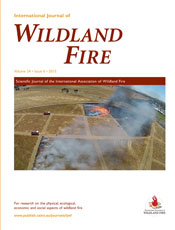International Journal of Wildland Fire
Volume 24
Number 6 2015
An efficient suppression response has been demonstrated to reduce the size and subsequent impacts of wildfires. This has stimulated the development of fire suppression models that form part of decision support systems. We review the historic development of such models, assess the state of the art and provide perspectives on future research.
New prevention programs were shown to reduce the number of human-caused wildfires for selected US tribal lands. Prevention reduced wildfires caused by children, equipment, escaped campfires and fire-use, but did not reduce smoking- or arson-caused wildfires. Average benefits exceeded average costs for the programs we examined.
Fire is a common hazard in forested areas in arid and semi-arid regions. This study presents a static fire hazard model to identify the locations in north-eastern Iran that are prone to fire hazard. The results show that approximately 14% of Golestan Province in Iran is subject to ≥66% fire hazard level.
We evaluated relationships among wildfire, prescribed fire and drought over a 30-year period at Fort Benning, Georgia, USA. Prescribed fire has been effective in reducing annual wildfire incidence over time. Wildfire incidence and areal extent were highest during drought years when the cumulative area treated by prescribed fire was low.
A technique for validating wildfire simulators using historical fire data is presented. The technique was applied to a large wildfire occurring in Western Australian sand-plain heathlands. Historical fire spread was compared with that produced by the Australis simulator. Issues regarding the quality of data available for simulator evaluation are discussed.
We develop a computational model to investigate the spread of smouldering fires into peat columns with heterogeneous property profiles. Modelling results reveal that the critical moisture for extinction can be much higher than previously reported values for ignition, thus helping to understand the role of moisture in peat fires.
We studied the effect of fire temperatures on the survival, regrowth and reproduction of Senecio bracteolatus and Mulinum spinosum shrubs in Patagonian grasslands. High-temperature fire decreased survival and growth of S. bracteolatus plants, whereas low-temperature fire enhanced early seed production. Mulinum spinosum plants survived at high temperatures but delayed seed production.
We tested the effect of CO2 level and soil P availability on leaf flammability and fuel load accumulation in plant species from Cumberland Plain Woodland, western Sydney. The results showed that leaf flammability and fuel load accumulation increased under elevated CO2 levels whereas soil P availability had no effect.
In this study we examined the dynamics of senescing grass fuels in relation to the proportion of live and dead fuels and their associated moisture content. We developed models aimed at quantifying the proportion of green and senescing fuels from knowledge of the proportion of dead fuel, and actual curing values from visual assessment estimates.
We conducted a field-based experimental burning program to study the effect of grass senescence and live fuel moisture on the spread rate of a fire. Curing level was found to be the best descriptor of the damping effect of live fuels in the spread rate of grassfires. A model for this effect is proposed.
We evaluated the effects of winter grazing on fuels in rangelands. Winter grazing compared with no grazing decreased fine fuels and increased fuel moisture content without increasing exotic annuals or negatively impacting native plants. The cumulative effect of winter grazing on fuels reduces wildfire risk and potential severity.
Models describing fire effects on water, soil and biodiversity were applied across the north Australian tropical savannas using recent fire mapping. An existing improved fire management example, and the published effects of climate change, were modelled and indicated that improved management, even with the effects of climate change, is better.




